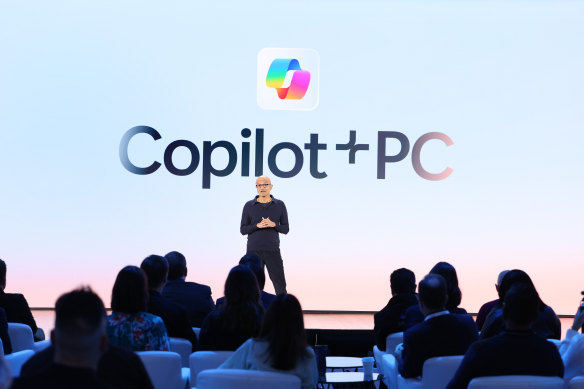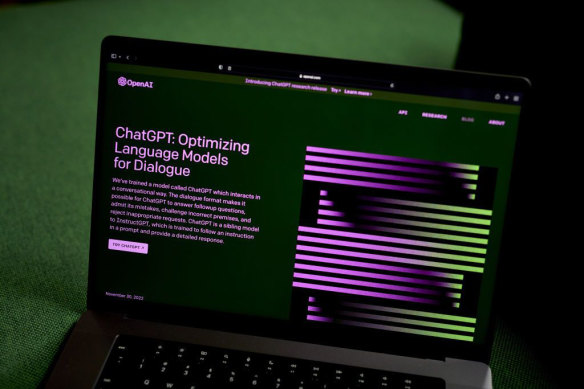By Matt Day
Microsoft Corp is betting that artificially intelligent assistants will transform workplaces around the world, generating new excitement and revenue for a very old product: the Office productivity software used by hundreds of millions of workers.
Few doubt the promise of the technology. The lineup of AI assistants, which Microsoft calls Copilots, can automate manual tasks and generate or summarise text and images.

Microsoft has poured millions of dollars and significant resources into its new Copilot AI tools.
But this is no plug-and-play offering, according to customers and people who advise them. First, companies have to figure out what data to feed into a Copilot so it can perform effectively without creating a new target for hackers or revealing information employees aren’t supposed to see. That takes time and money.
Early adopters say that while Copilots excel at distilling information, they fall short in other respects. The assistants struggle to understand the context of some requests and handle commands involving multiple apps. As a result, widespread adoption is expected to take a while. Jefferies analysts predicted in June that Microsoft won’t see a financial windfall until the first half of 2025.
“It is a success in terms of being the most visible business productivity enhancement based on artificial intelligence that exists today,” said Adam Preset, a Gartner Inc. vice president and analyst, who says he’s talked with more than 1000 clients about deploying Microsoft Copilots. “But in terms of its impact on work by the average digital worker, the jury is still out.”
Microsoft, which is scheduled to report earnings next week, hasn’t disclosed how many customers are paying for Copilot subscriptions but says plenty are making the leap despite growing pains. Jared Spataro, the corporate vice president who oversees workplace AI tools, says some customers have simply decided: “‘Hey, we haven’t worked it all out yet, but we can see the writing on the wall. We’re gonna make an investment in this and figure it out.’”
Even for trained employees, Copilot has its shortcomings.
In the nearly two years since OpenAI introduced ChatGPT to the world, the technology industry has raced to deploy and refine tools based on the sort of large language models that power the popular chatbot. Microsoft, which has access to OpenAI’s technology through its $13 billion investment in the start-up, has embarked on a company-wide effort to embed assistants in its products.
The Copilot branding, an effort to suggest that AI is here to help, not replace, its human masters, emerged at GitHub, Microsoft’s coding platform. Over the past couple of years, the GitHub Copilot has begun to automate the most tedious aspects of software development by finishing lines of code with just a few prompts. The AI assistant had 1.8 million paying customers at the end of March, and Microsoft is eager to duplicate that success elsewhere.
Last November, the company widely released the corporate version of its AI assistant – called M365 Copilot — to large customers, then began offering it to small businesses two months later.
Paying for the assistant, which is designed to automate aspects of Outlook, Word, PowerPoint and Teams, doubles the cost of a monthly subscription to about $60 per user for corporations, though those that sign multiyear contracts typically get discounts.
Ernst & Young said in June that it would equip some 100,000 of its workers with Microsoft’s software for salespeople, a titanic order that includes Copilot. The professional services and accounting company lost little time deploying the sales technology to tens of thousands of workers, but says the AI assistant is rolling out at a slower pace.
‘Pixie dust’
EY engineers are working to make sure that when an employee asks for the status of a contract, for example, Microsoft’s bot knows where to fetch the information. Small groups are also evaluating AI tools built for Outlook email software and the Teams videoconferencing service ahead of a broader deployment within EY and to its own customers.
“A lot of people think AI is just pixie dust they can sprinkle, and it’s gonna make their lives easier,” said Keith Mescha, an executive director with the EY unit that helps clients use Microsoft products. “There’s actual effort and work to make sure they do it right.”
Training employees how to use Copilot is key, so Microsoft created a set of how-to guides and offered an early adopters program. Lumen Technologies Inc., which got access to the software before it was widely available, says it has deployed M365 Copilot to a “couple of thousand” employees.
Lumen marketing chief Ryan Asdourian said the assistant saves salespeople more than three hours a week researching prospects, which he estimated would translate into about $50 million in additional annual revenue if those employees invested the free time back into their jobs.
Training is key
That’s peanuts for a company of Lumen’s size, but Asdourian says the anticipated bump in sales is more than enough to justify the extra subscription outlays. “One of the things that we’ve done really well is we’ve taught people how to use the product,” he said. The results are “significantly better when your employees know how to use it.”
Even for trained employees, Copilot has its shortcomings, analysts and early adopters say. Users who assumed they’d be dealing with one assistant capable of jumping across apps found themselves re-entering the same query into multiple chat windows, an experience that Spataro likened to getting passed around among clueless customer support agents.
In Excel, Microsoft discovered that Copilot couldn’t be a spreadsheet wizard if it didn’t speak Python, the coding language widely used for data analysis. And though Copilot can generate a functional PowerPoint presentation, it has struggled to take the sort of step-by-step input necessary to create a great one.
Fixes to those issues have rolled out or are coming in future updates, Spataro said.
Meanwhile, companies are slowly learning what information to feed into the software. Give it too little to chew on, and Copilot is essentially a very expensive email drafting tool. Give it too much, and an office worker might call up a colleague’s salary or peek at projects unrelated to their job.
That quandary – and the cost of painstakingly reworking data storage or software permissions – represents “the biggest impediment” to widespread adoption of the software, according to Gartner’s Preset.
When M365 Copilot rolled out last November, the software, by default, could reach into any store of data an employee was permitted to access. Microsoft has since given corporate IT departments the capability to whitelist the troves it wants Copilot to tap into and made it harder for workers to go fishing for things such as poorly secured passwords.

Microsoft is a major shareholder in ChatGPT.Credit: Bloomberg
Unlike a new feature in a software update, successfully deploying Copilot tends to require hiring consultants or devoting training resources that could be spent elsewhere.
“Most companies are not ready” to use Copilot without changing how they label and store information, said Matt Radolec, a vice president with Varonis Systems Inc., which helps companies secure Microsoft Copilot and other cloud-computing products. “It’s only as good as what you put into it.”
Most industry observers expect Copilot to eventually generate significant recurring revenue for Microsoft. Analysts with UBS Group AG surveyed big corporate technology buyers earlier this year and found they were testing M365 Copilot with about 14 per cent of their employees. It would be a victory for Microsoft if just half of those workers wound up staying on as paying customers, the analysts wrote in a research note in June.
Microsoft’s Spataro said the subscription price reflects the value Copilot brings customers and the cost of running the service. Asking the assistant to summarise a trove of financial documents requires much more computing horsepower than making edits to a Word document.
“We feel like it’s not just an incremental feature enhancement,” he said, but “the culmination of a couple of decades of information technology innovations.”
Bloomberg L.P. With assistance from Dina Bass.
The Business Briefing newsletter delivers major stories, exclusive coverage and expert opinion. Sign up to get it every weekday morning.